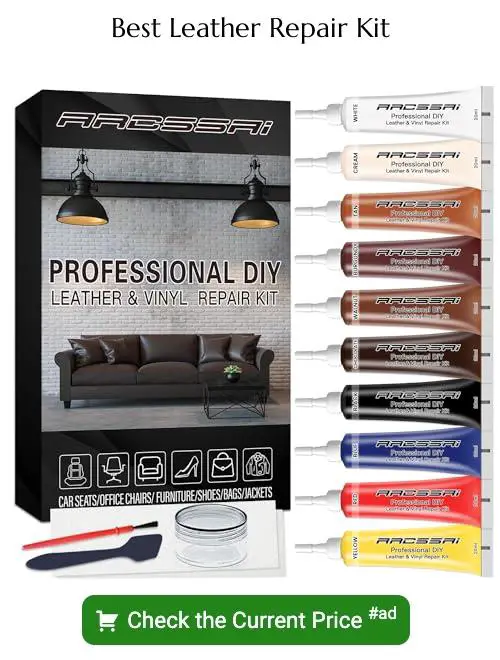Last updated on
Learn practical steps to repair a leather couch in this comprehensive DIY tutorial, restoring its original charm and extending its lifespan.
Key takeaways:
- Use a leather repair kit for various types of damage.
- Clean the leather couch with a leather cleaner before repairing.
- Apply a leather conditioner to maintain softness and durability.
- Follow step-by-step instructions for repairing a tear.
- Regularly clean and condition leather furniture to prevent wear and tear.
Table of Contents
PRODUCTS REQUIRED
Before embarking on the repair of a leather couch, ensuring you have the right products is crucial for success. A leather repair kit is the cornerstone of your repair process, usually comprising adhesive, backing fabric, and a variety of grains and colors to match your couch. Leather cleaner is necessary to remove dirt and oils that could interfere with the repair process. Using a leather conditioner post-repair not only restores the leather’s suppleness but also helps prevent future cracks and tears. Always remember that high-quality materials yield better, longer-lasting results.
Leather Repair Kit
A well-chosen leather repair kit comes with an array of tools and solutions to address various types of damage, from small scratches to larger rips. These kits typically include a selection of colored compounds that you can mix to match the hue of your sofa, adhesive to bond surfaces, a backing fabric for patching holes, and a finish to apply for a seamless look.
Step-by-step instructions guide you through the process, allowing for DIY efficiency.
When using the kit, precision is key. Applying too much adhesive can create a stiff spot, while insufficient color matching can leave the repair visibly noticeable. Focus on blending the repair into the surrounding area for a near-invisible mend.
It’s advisable to practice on a sample material before tackling the actual damage to gain confidence and skill.
Leather Cleaner
Before tackling any repairs, ensuring your leather couch is free from dirt and oils is crucial for the adhesive and patches to work effectively.
Leather cleaner is specially formulated to safely remove surface grime without drying out or damaging the material.
When applying, use a soft cloth in circular motions for a thorough clean and avoid soaking the leather.
This step not only prepares the surface but also prevents dirt from becoming trapped within the repair, which could lead to more damage over time.
Remember, a clean surface is key to a successful leather repair.
Leather Conditioner
Leather conditioner plays a crucial role in maintaining the softness and durability of your leather couch.
After cleaning the couch and completing any repairs, apply a leather conditioner to keep the material from drying out and cracking.
This step is especially important if the couch is frequently exposed to sunlight or sits near heat sources.
Using a soft cloth, apply the conditioner in a circular motion, covering all leather surfaces.
This helps to rejuvenate the fibers within the leather, ensuring that it remains pliable and resistant to future wear.
Allow the conditioner to absorb for the time specified on the product label—typically 10 minutes to a few hours—before buffing it gently with another clean cloth.
Conditioning should be done every 6 to 12 months, or more frequently if your leather couch is in a high-traffic area or used regularly.
Not only does this extend the life of your furniture, but it also keeps it looking its best.
Remember, a proactive approach with leather conservation is far more effective than trying to reverse damage after it occurs.
STEP BY STEP GUIDE: REPAIRING A TEAR ON A LEATHER SOFA
Begin by assessing the size and location of the tear; this will influence the approach you take. Clean the affected area with a leather cleaner to remove body oils, dust, and dirt that could prevent a good bond.
Once dry, apply a thin layer of leather adhesive beneath the edges of the tear. Press the edges together, wiping away any excess glue that seeps out, to ensure a seamless repair. It’s crucial to let the adhesive dry completely; this may take a few hours or as specified by the product.
To reinforce the repair, apply a leather sub-patch under larger tears if your kit includes one. This provides additional support to the damaged area.
After the tear is bonded and the adhesive has set, a leather finish in a color that matches your couch can be applied over the mended spot to seal the deal and disguise the repair. Allow the finish to dry following the timeline recommended by the manufacturer before using the couch. Remember, patience in letting each stage set is paramount for a lasting repair.
FAQ
Can you repair a damaged leather sofa?
Yes, a damaged leather sofa can be repaired, primarily through cleaning the affected area with an approved leather cleaner and then fixing any cuts, scuffs, or scratches.
How do you fix a worn spot on a leather couch?
To fix a worn spot on a leather couch, apply a leather repair compound starting from one corner, covering the entire surface, and then use a clean paper towel to remove any excess compound that may build up in the seams or ridges.
Is it worth repairing a leather couch?
Whether it’s worth repairing a leather couch largely depends on the quality of the leather – with high-quality full-grain or top-grain leather, and valuable designer or vintage pieces showing more worthiness for restoration.
What are the most effective products for patching up a leather sofa?
The most effective products for patching up a leather sofa include leather repair kits, leather filler, leather adhesive, and leather conditioning treatment.
How can you prevent further wear and tear on your leather furniture?
To prevent further wear and tear on your leather furniture, regularly clean and condition it, avoid exposure to direct sunlight, and promptly attend to any spills or stains.
Can professional restoration significantly extend the lifespan of a leather couch?
Yes, professional restoration can significantly extend the lifespan of a leather couch.





